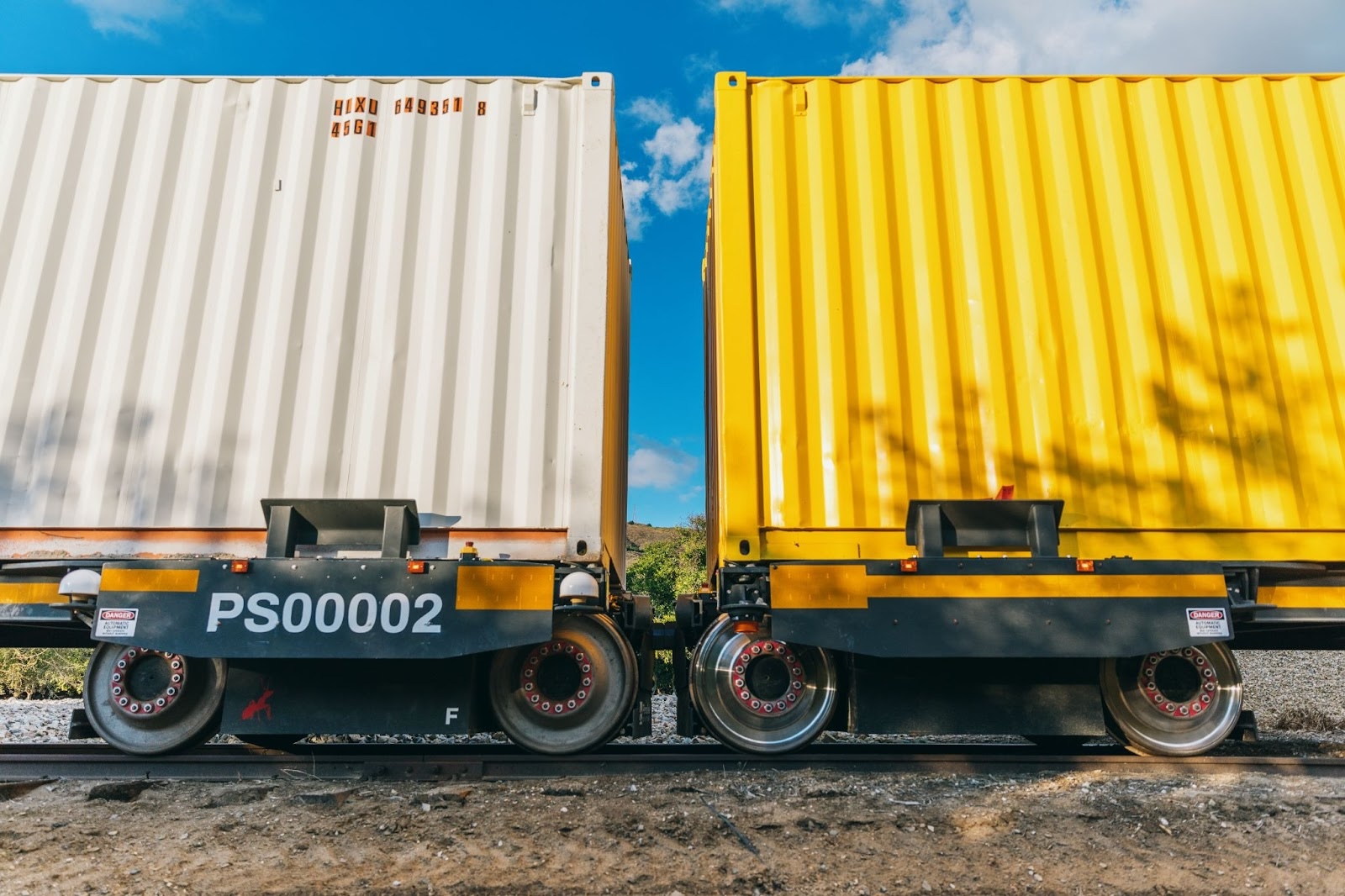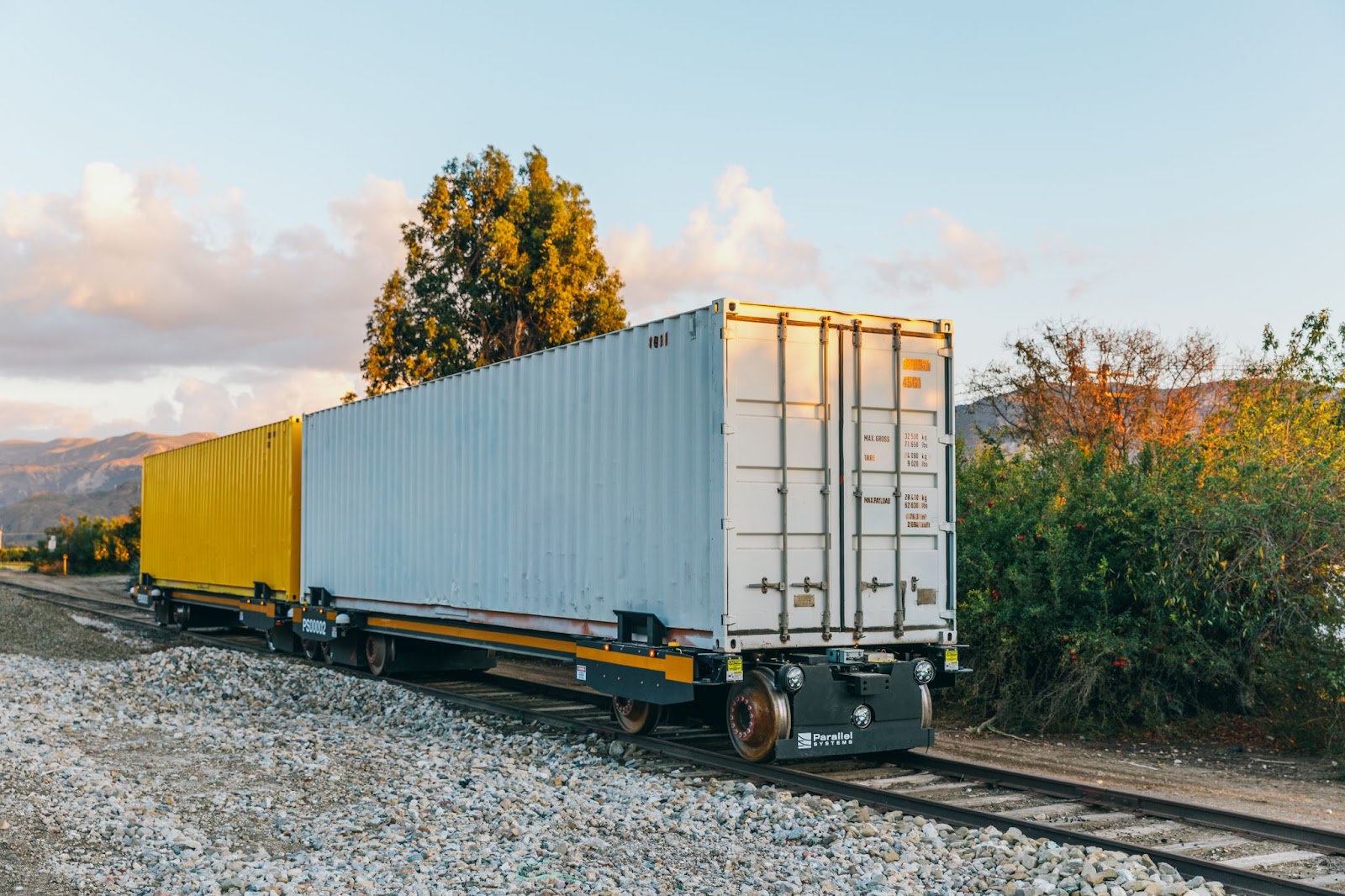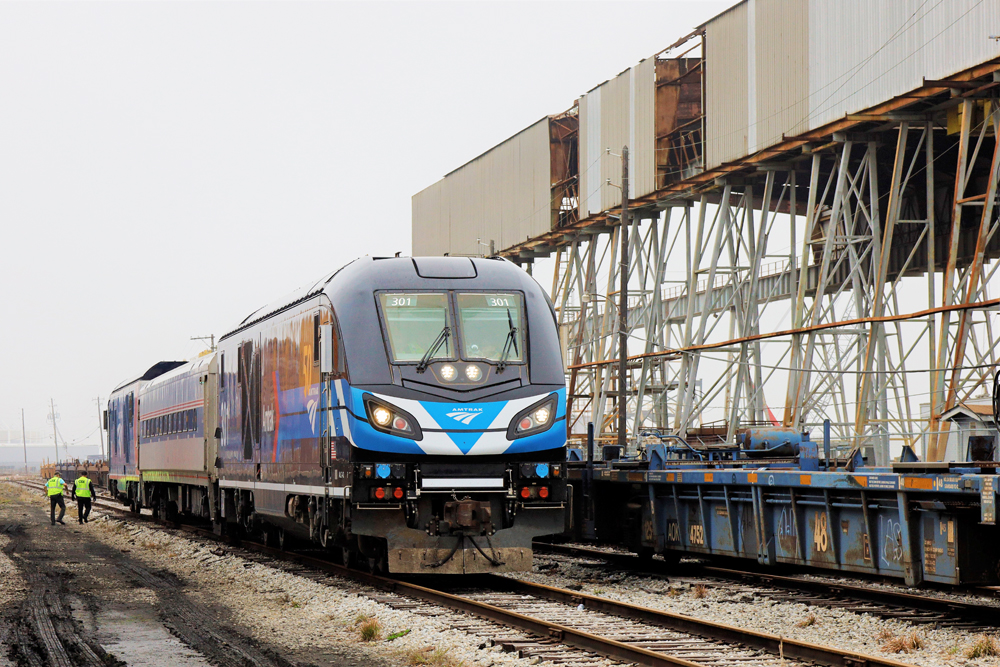
LOS ANGELES — Parallel Systems today for the first time demonstrated the platooning capability of the autonomous, battery-electric container cars that it is developing for short-haul intermodal service.
The self-propelled cars lack traditional Janney railroad couplers. Instead, they can operate in platoons through bumper-to-bumper contact and coordinating tractive effort among all of the cars in the consist. Because the cars use electric brakes, building platoons is fully automatic because there’s no need to couple air hoses.
Parallel demonstrated the technology on its Southern California test track. The cars can travel in platoons of up to 50 cars, which improves aerodynamics while making better use of railroad capacity.
“Our platoon testing began in October 2023, and the performance has been consistent with our modeling and simulations, which is exciting right out of the gate,” Matt Soule, Parallel’s co-founder and CEO, said in a statement. “The vehicles have remained connected according to plan, allowing us to plan expanded platoon testing with increased speeds, greater number of vehicles, and braking. Introducing platooning will help the rail industry address a range of critical challenges, including sorting and routing freight more quickly and keeping railroad crossings open for roadway and pedestrian traffic.”
Parallel says its platooning technology could one day eliminate the need for yards because the railcars can attach and detach independently from platoons, allowing railroads to sort freight anywhere along the network where there is a switch.
The Department of Energy recognized Parallel as a high-potential, high-impact energy saving technology when it awarded the company approximately $4.5 million as part of its Advanced Research Projects Agency-Energy initiative. The purpose of the award is to test how well Parallel’s zero-emissions rail vehicles integrate with real-world railroad operations and to evaluate supply chain resilience and reduction in energy usage, and associated emissions.
In August, Parallel and two Genesee & Wyoming short lines filed a waiver request with the Federal Railroad Administration that would, if approved, permit testing of the equipment in Georgia.
FRA spokesman Warren Flatau says the agency hopes to publish a decision on the waiver request in the next few weeks.
“We have been actively providing technical assistance and regulatory insight to Parallel Systems over the last several years. We are reviewing the August Georgia Central Railway and Heart of Georgia Railroad submission … requesting temporary suspension of locomotive and operating practices regulations in order to perform the tests planned for 2024 in the Heart of Georgia,” Flatau says.

Note: Updated at 9 a.m. Central on Dec. 21 with comment from FRA.














Obviously , the first application would be shortlines . Instead of one train a week , they can send a container to a customer anytime. Doesn’t really matter how fast it travels , its still going to arrive sooner , unless its the day of the week the train normally runs .
What will their top line haul speed be. Video infers, seems to indicate what my guesstimate is 20 mph or less. Will they reduce speed for grade crossings? Do they have warning horn? Lights?
G & W is involved. Looks to me like they see potential in it.
Do any articles detail cost of trackage rights/usage assessed by parent rail carriers in order for this firm to use the parent ROW? If the point is to cannibalize freight currently traveling on a regional short line or a C1, most regionals and C1’s are very leery allowing “cherry picking” of freight. Some C1 contracts have tonnage and volume commitments of the entire spectrum of the contracted parties.
Parallel Systems seems to be a technology developer and manufacturer. Their customers would be railroads and rail car leasing companies. I don’t see them as freight carriers.
The real question is how these units integrate with the existing railroad infrastructure. Can the autonomous cars travel 500 miles between charges? How do they charge? Alternatively, can a railroad put an engine at the rear of a platoon of cars to push it along with some type of driving vehicle at the front for a train crew? I don’t know their model for moving the autonomous vehicles over long distances. Would they lift the container off the autonomous vehicle and drop it on a conventional container platform?
Could not the same technology be applied to box cars, tank cars, hoppers, etc? The biggest savings isn’t in eliminating the crew. It is in eliminating the classification yards as each car travels directly from origin to destination, joining and leaving platoons as needed. Service would be much faster and more reliable.
Not entirely true.. Too much classification is expensive… Not enough classification is expensive..
Curious how parallel systems believes yards won’t be needed..
Must be lack of vision on my part, but I watch this video and think a couple hill folk from Kentucky could achieve the same result with deck-over trailers and two used F-250’s and still have $39Million left over to make some decent bourbon.
Wow…I just hope that Parallel Systems isn’t using the same computer software that Google uses for its autonomous cars. The last thing we need is trains having accidents with each other.
i doubt if that will ever work
This concept will not fly with routes requiring a certain number of axles, or a LOT of grade crossings. I also foresee this going nowhere because engineers, trainmen, dispatchers, conductors, a couple hundred more jobs, and basically EVERY union on the railroad will be up in arms about lost jobs.